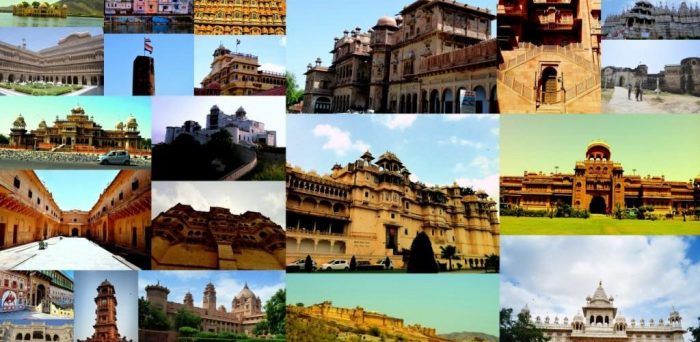Rajasthan is where all the country’s similes and metaphors appear to have come together. Sand dunes, wooded hills and amazing lakes, Splendid Forts & places, men and women in colourful turbans and skirts, bustling towns and quiet villages, camels, elephants and tigers, harsh sunlight and the cool evening breeze – are all there in abundance. Here is a list of Most Visited Forts and Palaces in Rajasthan.
Mehrangarh Fort, Jodhpur
Perched on a 150 m high hill its sprawl is the most formidable and magnificent fort in Rajasthan. Rao Jodha founded it in 1459 but subsequent rulers of Jodhpur have also added to it over the centuries. A meandering road leads to the from the city 5 kms below. Battle scars of canon ball hit by attacking armies of Jaipur can still be seen on the second gate.
To the left is chhatri of Kirat Singh Soda, a soldier who fell on the spot while defending the fort against the armies of Amber. There are seven gates, which include Jayapol meaning victory built by Maharaja Man Singh to commemorate his victories over Jaipur and Bikaner armies. Fattehpol also meaning victory gate was built by Maharaja Ajit Singh to mark the defeat of Mughals.
And Lohapol meaning iron gate has a moving memorabilia on palm print of the queens of Maharaja Man Singh who threw themselves on his funeral pyre in an act of sati [self-immolation]. The palm imprints still attract devotional attention and are covered by vermilion paste and paper-thin silver foil.
Mehrangarh fort is about 5km from Jodhpur Town. Guarding the city below, crowning a perpendicular cliff, the fort was founded by Rao Jodha in 1459 AD when he shifted his capital from Mandore.
Standing sentinel to the city below, it overlooks the rugged and rocky terrain and houses a palace intricately adorned with long carved panels and latticed windows exquisitely wrought from red sandstone.
The apartments within, have their own magic -the Moti Mahal (Pearl Palace), Phool Mahal (Flower Palace), Sheesh Mahal (Mirror Palace), Sileh Khana and Daulat Khana with a rich varied collection of palanquins, howdas, royal cradles, miniature paintings of various schools, folk music, instruments, costumes, furniture and an impressive armoury. The display of cannons on the ramparts near Chamunda temple is among the rarest in India. As you climb up, folk musicians revive the grandeur of a bygone era.
Kumbhalgarh Fort, Udaipur
Located 64 kms north of Udaipur in the wilderness, Kumbhalgarh is the second most important citadel after Chittorgarh in the Mewar region. Cradled in the Aravali Ranges the fort was built in the 15th century by Rana Kumbha. Because of its inaccessibility and hostile topography the fort had remained un-conquered.
It also served the rulers of Mewar as a refuge in times of strife. The fort also served as refuge to the baby king Udai of Mewar. It is also of sentimental significance as it is the birthplace of Mewar’s legendary King Maharana Partap.
The fort is self-contained and has within its amalgam almost everything to withstand a long siege. The fort fell only once that too to the combined armies of Mughal and of Amber for the scarcity of drinking water. Many magnificent palaces an array of temples built by the Mauryas of which the most picturesque place is the Badal Mahal or the palace of the clouds.
The fort also offers a superb birds view of the surroundings. The fort’s thick wall stretches some 36 kms and is wide enough to take eight horses abreast. Maharana Fateh Singh renovated the fort in the 19th century. The fort’s large compound has very interesting ruins and the walk around it can be very rewarding.
The Kumbhalgarh Fort also has a great significance by being the birthplace of Maharana Pratap and as the finest examples of defensive fortification in Rajasthan. The most interesting part is that this fort has a fort within itself. Named Kartargarh, the inner fort has a palace built by Maharana Fateh Singh after he had pulled down the old palace built by Rana Kumbha.
Some remains of the old palace are still there below the new one which includes the portion that had been occupied by Prithvi Raj. Kartargarh has 365 temples and shrines including one with a huge Shivlinga dedicated to Lord Shiva. The sanctuary is famous for its wildlife which includes- wolf, leopard, jackal and a variety of birds. The sanctuary is one of the few parks that allows people on horseback.
Jaisalmer Fort, Jaisalmer
Known as SONAR QUILA or the Golden fort, rising from the sand, the mega structure merges with the golden hues of the desert ambience and the setting suns in its most colourful shades gives it a fairy tale look. Its simply a magic, the bastions envelops a whole townships that consist of palace complex various security sources and the Havelis of rich merchants carved with an incredibly light touch, several temples and the residential complexes of the armies and traders placed strategically on the trade route, from where the ancient caravans passed en-route passing all the riches for the prosperity to an otherwise non source full kingdom.
These merchants served and acquire a great deal of power and noble status in the royal courts of Bhatti Rajputs who founded the state in the 12th century and proceeded further. But the rich merchant inspired by the classic style of the royals, constructed huge mansions (Havelis) adjacent to each other in the nature of medieval culture and profusely decorated walls and ceilings and intricately carved outdoors and interiors. The colourful art forms and somehow side kind the royal heritage and made it appear paler in comparison. The craftsmen were usually Muslims who were induced on their journey to exhibit their skills. The results were architectural purity that cannot be seen elsewhere.
The golden – yellow sandstone of Jaisalmer Fort, over 800 years old, crowns the Trikuta Hill. Within its walls, defended by 99 turrets, lies the old city, nearly a quarter of modern Jaisalmer. Seen from outside, the sight must be almost identical to what was seen by merchants on their overland camel caravans to central Asia. Once this desert outpost was an important gate for the trade route, and Jaisalmer grew wealthy on the proceeds. But the advent of commercial shipping relegated the town to relative obscurity. Exotic Rajasthan Tour will be the best match to see the rich past history of this magnificent city.
Rohet Fort, Near Jodhpur
Built-in the 16th century, the Rohet Garh Fort has arched gateways that lead to a central compound. All the rooms open into this compound. The resort has a beautiful décor with carved furniture, mementoes and paintings. The dining hall is decorated with a large collection of antique hunting rifles, shields, spearheads, daggers, tiger skins and trophies.
Luni Fort, Near Jodhpur
Fort Chanwa of Luni is an exceptional example of elegance and symmetry in Indian architecture of the last century. The entire fortress is carved out of the famous red sandstone of Jodhpur and with its ornately carved latticework friezes and intricate “Jharokhas”, it exquisitely captures the romance and grace of a bygone age.
The fort is composed of a lyrical complex of courtyards towers, water, wheels, stables, passages and unexpected stairways to secret pavilions and panoramic rooftops spanning the village below and the Thar horizon beyond. The traditional paintings on the walls harmoniously reflect the skill of the master craftsmen and the bygone days.
The village of Luni nestles in the shadow of the Fort walls and is a hub of activity with its many artisans fashioning metal, clay or wood into intricate forms and demonstrating the skills passed down over the centuries by their ancestors.
The village elders solemnly reflect the changing times under shady trees, while the children enjoy running around narrow carefree streets. The women, swaying in their brilliant Rajasthani colours go about their daily chores to give water and sustenance to the village.
The Fort has been beautifully restored to its former glory by its owners Maharaj Dalip Singhji, ( The youngest son H.H Maharaja Umaid Singhji) and his wife Rani Madhu. Each room has been created and decorated with its own particular charm and the many courtyards, verandahs and gardens all offer a setting and ambience set to capture your heart. Fort chanwas’s courtyards are peaceful havens where guests can unwind for the day and spend the afternoons leisurely reading or relaxing in the sun.
Bila Quila Fort, Alwar
This huge fort, constructed before the rise of the Mughal empire, stretches 5 km from north to south and 1.6 km from east to west and stands 304 metres above the city and 595 metres above the sea level. This huge fort has 15 large and 51 small towers and 446 openings for musketry, along with 8 huge towers encompassing it.
The fort has several gates – Jai pol, Suraj pol, Laxman Pol, Chand Pol, Kishan Pol and Andheri Gate. Also, there are remains of Jal Mahal, Nikumbh Mahal, Salim Sagar, Suraj Kund and many temples. Babar had spent a night at this fort and took away the hidden treasures to gift to his son, Humayun. Akbar’s son, Jahangir had also stayed here for some time during his exile. The place where he stayed is called Salim Mahal. The fort was finally annexed by maharaja Pratap Singh in 1775 A.D.
This is a huge fort, with its five kms of ramparts stands 300 Mts. above the city. Predating the time of Pratap Singh, it is one of the very few forts in Rajasthan which was constructed before the rise of Moghuls. Unfortunately, because the fort now houses a radio transmitter station, it can only be visited with special permission. The way to the fort goes near the collectorate office in the city. it is a climb up to the hill with a panoramic view all around. In the way, one can see the temple of Goddess Karani Mata.
The fort is believed to be constructed by Nikumbh Rajputs in 928 AD. It then passed into the hands of the Jats and the Mughals. In 1775 AD the fort was conquered by Maharao Raja Pratap Singh, the founder of the Alwar State.
The fort is 595 mts. above the sea level and 304 mts. above the city, and extends about 5 kms from north and south and 1.6 kms from east and west. It has 15 large and 51 small towers, which contains 446 loopholes for the musketry. And eight towers all around defend it . There are 3,599 kanguras , each containing two loopholes for musketry. The fort can be entered through six gates, namely Jai Pol, Suraj pol, Laxman Pol, Laxman Pol, Chand Pol, Krishan Pol and Andheri Gate.
Most of the structure inside the fort are in the ruins,but they reflect the grandeur of the bygone era. the are remains of Jai mahal, Nikhumbh Mahal ,Salim Sagar Pond,Suraj kund and many other temples. A dilapidated fortress, built in V.S. 1106(about 1049 AD) by Alagh rai and extended by his successors, also exists overhere.
The most distinguished visitors to the fort were the Mughal Emperors Babur who stayed overnight, and Akbar the Great,on his way to Fatehpur Sikri in 1579. Prince Salim son of Akbar also resided here during his exile, the palace where he stayed is called as Salim Mahal which is now in the ruins.
Junagarh Fort, Bikaner
One of the Most imposing forts of Northern India – Junagarh Fort has remained unconquered till date. This fort was built in 15th century by one of the most able and trusted generals of Akbar, Raja Rai Singh.
A high wall and deep moats surround the fort. The 37 bastions guard the fort and only two gates provide the access inside the fort. The Suraj Pol or the Sun Gate is the main entrance to the fort. The Junagarh Fort has defied all the attacks except for the brief stint by Kamaran who captured the fort but was unable to retain his victory more than 24 hours.
Inside the fort is a profusion of 37 palaces, temples and pavilions that are marvels in red sandstone construction. The palaces have exquisitely carved windows, balconies, towers and kiosks.The mirrors, paintings and carved marble panels in the Moon Palace are a treat for eyes. The Phool Mahal or Flower Palace was adorned with glasses and mirrors. The victory over Aurangzeb was celebrated by building the Karan Mahal.
The multi-storeyed Anup Mahal was the governance chambers for the rulers. The beautifully maintained rooms now display the treasures of the Royal family. Also worth visiting are the Ganga Niwas, Dungar Niwas, Vijai Mahal, and Rang Mahal. The fort museum has an extensive collection of illuminated manuscripts, jewellery, jars and carpets, arms and weapons, treaties, decorations and the ‘Farmans’.
This fort and it’s palaces were built between 1588-1593 by raja Raj Singh, a general in the army of the Mughal emperor Akbar. It has a 96 mt long wall, with 37 bastions and 2 entrances. The main entrance of the fort is Suraj pol or sun gate.
The fort encompasses many palaces amongst which the most spectacular ones are the Chandra Mahal or Moon palace, the Phool Mahal or Flower palace, both ornated with carved panels and mirrors and the Karan Mahal.
Karan Mahal was built in remembrance of the celebration of the grand victory over Aurangzeb. Durga Niwas, a fabulously painted courtyard and Ganga Niwas which housed a finely carved red sandstone front, are the other places of attraction in this fort.
Taragarh or The Star Fort, Bundi
The Taragarh Fort, also known as the Star Fort was built in 1354. It towers over the town and the surrounding countryside. A steep road up the hill, leads to an enormous gateway, topped by magnificent rampant elephants. Inside lies huge reservoirs carved of solid rock and the Bhim Burj, the largest of the battlements, on which is mounted a famous cannon. Views from the town and surrounding countryside are magical, especially at sunset.
Chittorgarh Fort, Chittorgarh
The fort is on a 280-hectare site on the top of a 180-metre-high hill, which rises abruptly from the surrounding plain. There are many palaces within the fort like Rana Kumbha Palace, Fateh Prakash Palace, Tower of Victory and Padmini’s Palace, which are a must see for the tourists. This hilltop fortress of Chittourgarh epitomizes the romantic and doomed ideal of Rajput chivalry.
The main places of interest within the precincts of the fort are the two towers known as the ‘Kirti Stambh’ (Tower of Fame) and the ‘Vijay Stambh’ (Tower of Victory). Besides these, there are several temples, reservoirs, and palaces originating between the 9th and 17th centuries AD. There is also a big complex of Jain temples within the fort.
The Kirti Stambh is a seven-storied structure with a cramped stairway of 54 steps. It is 30 feet at the base and narrows down to 15 feet at the top and is adorned with Jain sculptures on the outside. It is dated approximately around the 12th century AD. It is dedicated to the first Jain tirthankara or spiritual teacher, Adinath, and has an impressive five-feet-high statue of the saint.
However, the most imposing structure within the Chittourgarh Fort is the Vijay Stambh. This tower can even be seen from the town, which is located below the fort. This exemplary piece of architecture stands on a pedestal of 47 square feet and 10 feet high, while the tower alone stands at a height of 122 feet and is 30 feet wide at the base.
There are 157 steps and the stairs are circular. It is believed that the tower took 10 years to be completed. The tower was built around the 15th century AD, by Rana Kumbha, one of the most powerful Mewar kings. The tower was built to commemorate his victory over Mahmud Khilji of Malwa. The entire structure is covered with sculptures of Hindu deities and episodes from the two great Hindu epics, the Ramayana and the Mahabharata, with names given below each piece of sculpture.
The Sammidheshwara Temple is near this tower. Gaumukh reservoir and the palace of Queen Padmini are important spots to the south of the Rana Kumbha Palace. According to legend, Ala-ud-din Khilji, the Sultan of Delhi, was allowed to see the reflection of Queen Padmini in this palace.
A big water reservoir with water gushing out of a rock shaped in the form of cow’s mouth called ‘Gaumukh’ is close to the opening of the cave where Rani Padmini and the other women are believed to have performed jauhar. Other spots worth visiting are the Bhimtal Tank, Neelkanth Mahadev Temple, Meera Temple, Kumbha Shyam Temple, and Kalika Mata Temple dating back to the 8th century.
Lohagarh Fort, Bharatpur
Lohagarh fort, or the Iron fort was built in the early 18th century and took its name from its supposedly impregnable defences, which are said to be inspired by a description given in the epic, Ramayana. Maharaja Suraj Mal, the fort’s constructor and founder of Bharatpur, built two towers within the ramparts, the Jawahar Burj and Fateh Burj, to commemorate his victories over the Mughals and the British.
The fort was encircled and protected by deep moats, and according to a legend would fall “only when a crocodile swalled up all the water of the moat”. The gate of the Lohagarh has an interesting history behind it. It originally belonged to the fort of Chittourgarh but was carried away by Sultan Alauddin Khilji of Delhi. In the late 17th century it was brought back in triumph by the victorious Jat armies from the imperial capital of Delhi to Bharatpur.
Nahargarh Fort, Nahargarh
Nahargarh Fort is located on the sheer rugged ridge of Aravali Hills and it forms an impressive northern backdrop of Jaipur. Jaipur, the capital city of Rajasthan is certainly one of the must-visit travel destinations in India for many reasons. The fort overlooks the city and presents a glittering view of the city lights. It was built in 1734 and extended in 1868. Nahargarh meaning abode of the tigers was built by Jai Singh to bolster the defence of Amber.
The legend also have it that it was named Nahargarh after Nahar Singh a prince whose spirit would destroy the construction and not allow its progress further. So after a Tantrik prayer to the spirit it agreed to leave on condition that the fort is named after him. The Madhavendra Bhawan, built by Sawai Ram Singh II has uniquely a cluster of 12 identical suits for queens and at the head is a suit for the king himself.
The rooms are linked by corridors and retain some delicate frescos as well as toilets and kitchen hearths. It was used by members of the royal family for an excursion in summers and is now even a favoured picnic spot. Durg Cafeteria just above the entrance sells meals and refreshments, while Padao Restaurant on the west sells drinks around sunset.
Nahargarh or the Tiger Fort is the first of the three forts built by the kings of Jaipur. Built mainly in 1734 by Jai Singh II, it lies 6 km north-west of City Palace and provides some stunning views of the city of Jaipur down below to the Man Sagar Lake. The imposing fort harbours many legends and three kings have added their stamp at different times to the structures within the fort.
In the midst of this lake is a palatial duck blind, which was used for shooting parties by the erstwhile royal family. A royal retreat for the Maharanis, it was also used as a personal treasury for many years.
Beyond the hills of Jaigarh, stands the fort of Nahargarh like a watchful sentinel guarding Sawai Jai Singh’s beautiful capital. It overlooks the city from a sheer ridge to the north and is floodlit at night. Much of the original structures are now in ruins, but the lovely buildings added by Sawai Ram Singh II and Sawai Madho Singh II in the 19 th century are preserved in a good condition. Some of the rooms provide the most spectacular view of the city below.











Read 0 comments and reply